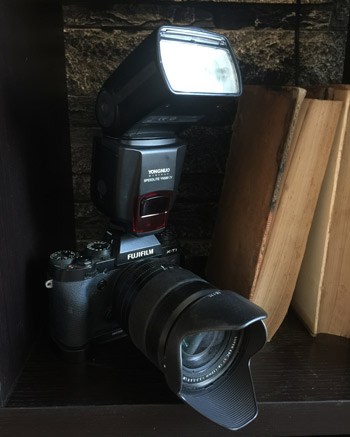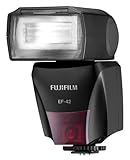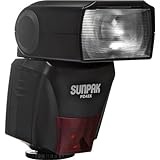
When I look at a new camera system, my first questions are about the lens system and the flash system, and THEN I'll consider the actual camera itself.
The main reason why I avoided the Sony camera system a few years ago (this is no longer an issue) is because their “standard” hotshoe was, well, not standard.
So when I decided to take a hard look at switching to Fuji from my Nikon full-frame camera, the flash system was one of the first things I tested.
I was surprised and relieved to find how well Fuji cameras handle flash systems from other manufacturers, which was a major reason why I ended up making the switch.
All Fuji cameras I have tested use standard hotshoes that are capable of working with third-party flash triggers and speedlights.
That's the good news! But there are some drawbacks to using flash on the Fuji system, which we'll dive into later.
First, let's have a look at the Fuji flash system and see how it compares with the stuff from other major manufacturers, then we'll consider third party flash systems like Phottix, Yongnuo, and others.
In the end, I'll give my conclusion on the best flash system for my Fuji XT1 mirrorless camera.
Fuji's Own Flash System
There isn't much good to say about the Fuji's own flash system except for three things
- It's inexpensive;
- I like the ingenious little pop-up flash on the Fuji XT1;
- And it will make you laugh every time you see a humungous Speedlight mounted to the hotshoe of a tiny little mirrorless camera.
It looks like a sumo wrestler riding on a goat.
Fuji produces four speedlights, but only one of them has any real use for anything other than simple on-camera flash: the Fujifilm EF-42 Speedlight flash.
The funny thing about that (two funny things in one article, whew!), is that Fuji didn't even produce the Fujifilm EF-42 flash (at time of writing).
It's actually just a Sunpak PZ42X flash with a Fuji logo bolted on it and a higher price tag. That's it.
You'll also notice that Sunpak produces the flash for all of the major camera brands—except Fuji.
Why? Because it DOES produce the flash, just under a different brand name.
So if you really want to have the official Fuji Speedlight on your camera, then do yourself a favor.
Just buy a Sunpak PZ42X and put a piece of electrical tape over the logo so nobody finds out your big secret.
Noticing any “subtle” similarities? It's because the Fuji flash is really just a Sunpak flash with a different logo on it.
Props to Fujifilm for having a better product image.
Sunpak's official image for the flash is a little overexposed and the plastic reflects the light of the flash. Tsk tsk.
Yongnuo Flashes on Fuji Cameras
Yongnuo is my flash of choice for my Fuji XT1.
I've been using Yongnuo flashes since before it was even cool to use Yongnuo flashes.
These little $70 flashes are extremely powerful, simple to use, and have a robust system around them for full feature flash photography.
Yongnuo is a Chinese company that makes inexpensive knock-offs of Canon flashes that are compatible with any brand of camera.
In the Yongnuo lineup, the most popular flash by far is the YN-560 line.
Right now the current model is the YN-560 IV.
This flash is all manual, has a strong power output, is easy to use, and is very reliable.
Reliability is something I really admire about Yongnuo.
The original YN-560 was plagued with issues, but since then the company has made these inexpensive flashes very dependable.
Sometimes it can be a trick to get the settings all right to make a trigger and flash sync together, but I don't think I've ever had a misfire with Yongnuo flashes when I have them set up correctly.
The system works well, and the radio signal can fire from a LONG distance away!
The big question is if you need high-speed sync and ETTL.
While Yongnuo does make speedlights with these features, they don't make any for the Fuji system.
For me, that isn't a limitation at all. High-speed sync seems like a must-have technology in a flash until you actually shoot with it and realize that the power output is so low that it rarely makes sense.
And for me personally, I find ETTL to be significantly more complicated and slow than using manual flash in most situations.
If you want to learn more about why this is, it's really worth the time to read my flash photography basics series of articles.
The Setup I Recommend for Fuji Flash
I'd buy one or two YN-560IV flashes and a YN560TX trigger.
The flashes can be used on the hotshoe of the camera or off the camera by putting the YN560TX on the hotshoe of the camera to trigger the flashes wirelessly.
When you go to buy your YN560IV and the YN560TX trigger, DO NOT WORRY that the listing doesn't specifically say it's for Fuji.
Just go ahead and buy the Nikon version.
I've personally tested it and I promise the Nikon version will work JUST FINE on Fuji.
The links above ARE to the correct models you'll need to get this to work.
If you have any trouble getting your Fuji camera to fire the flash, be sure to check out my YN560 HELP article!
You can get it at this link: https://improvephotography.com/42218/yn560-tutorial/

The Real Problem with Flash Photography on Fuji Cameras
One of my biggest complaints about the Fuji system is the very slow flash sync speed.
The flash sync speed is the fastest shutter speed at which the camera can shoot while still exposing the entire frame with the flash.
The flash sync speed on most fuji cameras is just 1/180, whereas most cameras can go up to 1/200, 1/250, or sometimes even 1/320.
That makes a huge difference for a photographer who wants to use flash in the daylight.
However, one possible solution for this problem is to simply use a neutral density filter.






Hi Jim, Does this setup up (560IV’s + 560 Tx) work for the XT-2. I just bought one a couple of weeks back and found that it does not work with the Nissin i40 so I’m a bit cautious now.
Thanks
Sold my A6000 + 4 Lens (16, 50, 16-50, 55-210) and with the money manage to bought a good as new 3 months old Fujifilm X-M1 (including 1 original extra battery) + 2 Lens (16-50, 50-230) and Fujifilm X30 + Brand new Yongnuo YT-560 TX and 2x Yongnuo YN-660 flashes.
Never regret the switch due to with my Sony’s the only items bought as brand new is the A6000 + 16-50 kit which is now 1.5 years old. I will say that most of the time, I ended up using my X30 + Yongnuo Flash System…no dought that the X-M1 even old model is still far better than X30 resolution wise but with Flashes, the X30 stands it ground and I love controling the slaves flashes by the 560TX in top of X30. Such a perfect combination even it is manual (no TTL). I never missed the Sony’s 11 fps and 24 mp for my type of photography. I love the colors of Jpeg coming out of Fujifilm. I want to preserved the exact setting of the exact moment that I took the photo. This Flash set-up that I have now opens a lot of new options and possibilities with my photography…
I’ve got a Canon 430EXII that works on my X-T10.
I’ve got an extension cable made by Promaster that says it’s for Canon Code6227. My question- Would you know of a trigger system that will work for my 430EXII and my Paul Buff lights?
I’m imagining there’s some sort of hot shoe adaptor I can get and I know promaster makes some nicer stuff now. Thanks!
FYI – Meiki makes a ttl flash for Fuji. It’s the MK 320 and it’s small like the Nissin except it’s much less. Neewer (NW 320) private labels them also. They can be had for $60 on eBay.
Hi all – does anyone have a Fuji XT2 body and can either confirm that the Yongnuo set up works with it or recommend an alternative setup? I’m eager to get something ordered and keep reading conflicting advice – resulting in much confusion!! :-/ The new Fuji EF -X500 flash is not receiving great reports Re lack of radio, which is disappointing at the increased cost! Would rather get a third party set up and an additional flashgun with my money, ideally with a faciliy that will work with TTL and HSS although am happy myself in manual so that’s not a must. Can anyone please help?? Thanks all
Yes, the XT2 does indeed work with the YN560 recommended here.
Hello Jim. I have a question.
I have a Fuijifilm X100T and a Yongnuo 568ex ii for Canon. If I connect the flash directly to the camera in the hoy shoe works fine or its dangerous and could damage my camera?
Thanks!
Regards
I ordered the Nikon version from abroad and it is paid on its way.
Now I read you’ll need the Canon version of the YN560TX trigger to make it work on the Fuji.
Also the link on your website is not to the Nikon but the Canon version. How confusing….
” THE SETUP I RECOMMEND FOR FUJI FLASH
I’d buy one or two YN-560IV flashes and a YN560TX trigger. The flashes can be used on the hotshoe of the camera or off camera by putting the YN560TX on the hotshoe of the camera to trigger the flashes wirelessly.
When you go to buy your YN560IV and the YN560TX trigger, DO NOT WORRY that the listing doesn’t specifically say it’s for Fuji. Just go ahead and buy the Nikon version. I’ve personally tested it and I promise the Nikon version will work JUST FINE on Fuji. The links above ARE to the correct models you’ll need to get this to work.”
JR: I have investigated this, and believe there will be little difference between the Canon and Nikon versions for Fuji users. From Amazon.co.uk:
“Attention: This listing is selling a YN560-TX Nikon version. (The difference between Nikon version and Canon version is only the wake-up function. When a YN560-TX Nikon version works on Nikon cameras, it can wake up a sleeping YN560-III flash, while on Canon cameras it can not do so. For the other cameras Pentax, Fujifilm, Panasonic, Sony, Sigma, the wake-up function is not available either.)”
Caveat: I have no personal experience of this system yet.
I have commented below.
Brian H.: Thanks Brian, I received the flashes (2x YN-560IV and 1x YN560TX for Nikon). All works without a problem on my Fuji XT-1. Didn’t try the X100T. I can manually adjust the zoom and the flash intensity of camera via the YN560TX (the latter even separately when using different channels for each Flash). Flashes are pretty big (which is no issue when used to studio flashes and using them off camera…) and they really look solid. I used the manual as described here, didn’t even bother to read the enclosed manual. I payed about 145 euro’s for the whole set including shipping costs from abroad. My other choices were the Fuji EF-X500 or the Nissin i60A. But for a similar setup that would have been a quite different price tag…. For someone like me the the Yongnuo lineup seems to be good and cheap choice.
Today I also tried the “Nikon” combo on my X100T. As expected no problem. Ordered myself a 3rd YN-560IV and spare YN560TX. For the money I could not leave it and now I have 3 flashes that I can all manually operate separately via the YN560TX
Hi all,
Did anyone test the Yongnuo YN-622N TX controller with an SB-900 on the X-T1 or X-T2 ? Does it work and is it possible to remotely control the flash power with such a combination ?
Thanks in advance.
Defeating the objext of using wireless remotes and needing line of sight and a fuji camera with built-in flash but :
1.put the youngnuo speedlite into slave mode
2.turn the camera built in-flash compensation down to use as fill (-1 stop as starting point). Check line of sight between camera flash and speedlite sensor.
3.compose focus and shoot.
Check result and adjust flash compensation on camera or speedlite until good results.
Hope this helps.
I use the Vello Freewave on my x-t1 and I can sync up to 1/250 without any “black bars.” Well, I lied there is a really faint and thin one at the bottom of the image and it’s easy to crop in post. However, I’ve been able to sync up to 1/200 without any issues. Also, if anyone is interested – I’ve used the Cactus V6ii with HSS. However, there is quite the setup process. I don’t use HSS much so it wasn’t worth it to spend nearly $100/transceiver. I believe nissin also makes an air commander for Fuji that is compatible with the i60a, but you’re also spending about $400-450 because the two are not sold in a kit.
Bonjour,
J’ai 1 X-T1
1 contrôleur YN622n TX (version Nikon)
2 récepteurs YN622n II (version Nikon) pour 2 flash Nikon SB800
les flash sont règlés sur SU4
les flash ne fonctionnent qu’en mode manuel, donc beaucoup de tatonnements
Après réglages du canal sur flash et YN622n TX et test pour contrôle de la communication entre les deux ,le contrôleur n’envoie pas les réglages sur les flash (modif. focale, diaph, puissance du flash) je fais les modifications sur les 3 acteurs (un peu fastidieux)
Voir fujilove.com pour version Yongnuo yn622c TX (Canon) mode Legacy
Sinon avec flash Fuji fourni sur griffe et SB800 mode SU4 (en CLS) cela marche pas mal
Thanks for this article, it’s very helpful. I was wondering, I have a NIKON SB-600 flash with I would like to use in combination with 2 Yongnuo YN-560IV flashes and a YN560TX trigger (and my Fuji X-T10). Would you know if that will work? Or should I use another trigger? The information I found is unclear about it. Thanks! 🙂
Based on this article, I bought 2x 560 IV’s and the 560-TX (Nikon version) for my Fuji X-T10. They work perfectly in manual mode, adjusting the flash output from the TX. Thanks for this posting, very helpful.
i need a great flash for my pro2 camera
Hi Folks,
Just to share the test results I just recently completed using Yongnuo RF-603 remote flash controllers.
THE SETUP
1) Main flash trigger = Yongnuo RF-603C flash controller mounted on X-T10
2) Flash setup # 1 = Yongnuo YN560 III flash unit (has a built-in flash trigger receiver)
3) Flash setup # 2 = Pentax AF200T flash unit mounted on Yongnuo RF-603N flash controller
THE RESULTS
1) All flash controllers indicated ‘Ready’ status (shown by two green LED lamps on each controller – left and right side). This status was achieved ONLY after the X-T10 was powered on. When the X-T10 was still off, only one green LED was lit or on (the ‘power on’ indicator) on each flash controller.
2) Pressing the test button on the main flash trigger on the X-T10 caused the ‘status’ LED on all the controllers to briefly turn red, then back to green again, indicating proper communication among the controllers.
3) Pressing the shutter button on the X-T10 to take a picture successfully triggered both flash units.
CONCLUSIONS FOR THE ABOVE SETUP
1) Using the RF-603C to control other RF-603N works properly.
2) The old Pentax AF200T flash unit gets properly triggered by the RF-603N.
FURTHER TESTING PLANS
1) Use the RF-603N as the main flash controller for a mix of RF-603N and RF-603C controllers. Had briefly tested this setup, and it seemed that the other flash controllers did not achieve the ‘ready’ status; this test was done very quickly due to time constraints, and I may have overlooked other checks or settings.
2) Test older flash units from other brands.
3) Perform the same test using the X-M1.
Hope this helps!
—
I use fuji X-T20, is yn560tx which for canon can be used …?
Thank you so much for this great article. I have the Yongnuo flash mentioned in this article and it was working just fine. Then I upgraded to Fujifilm X-T20 and now when I install flash on hotshoe, camera battery gets warm and just empties much fastest than it should.
I don`t think it might be a compatibility issue. Should I check with seller and tell them about it, or I should go with Fuji own flashes?